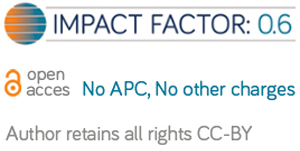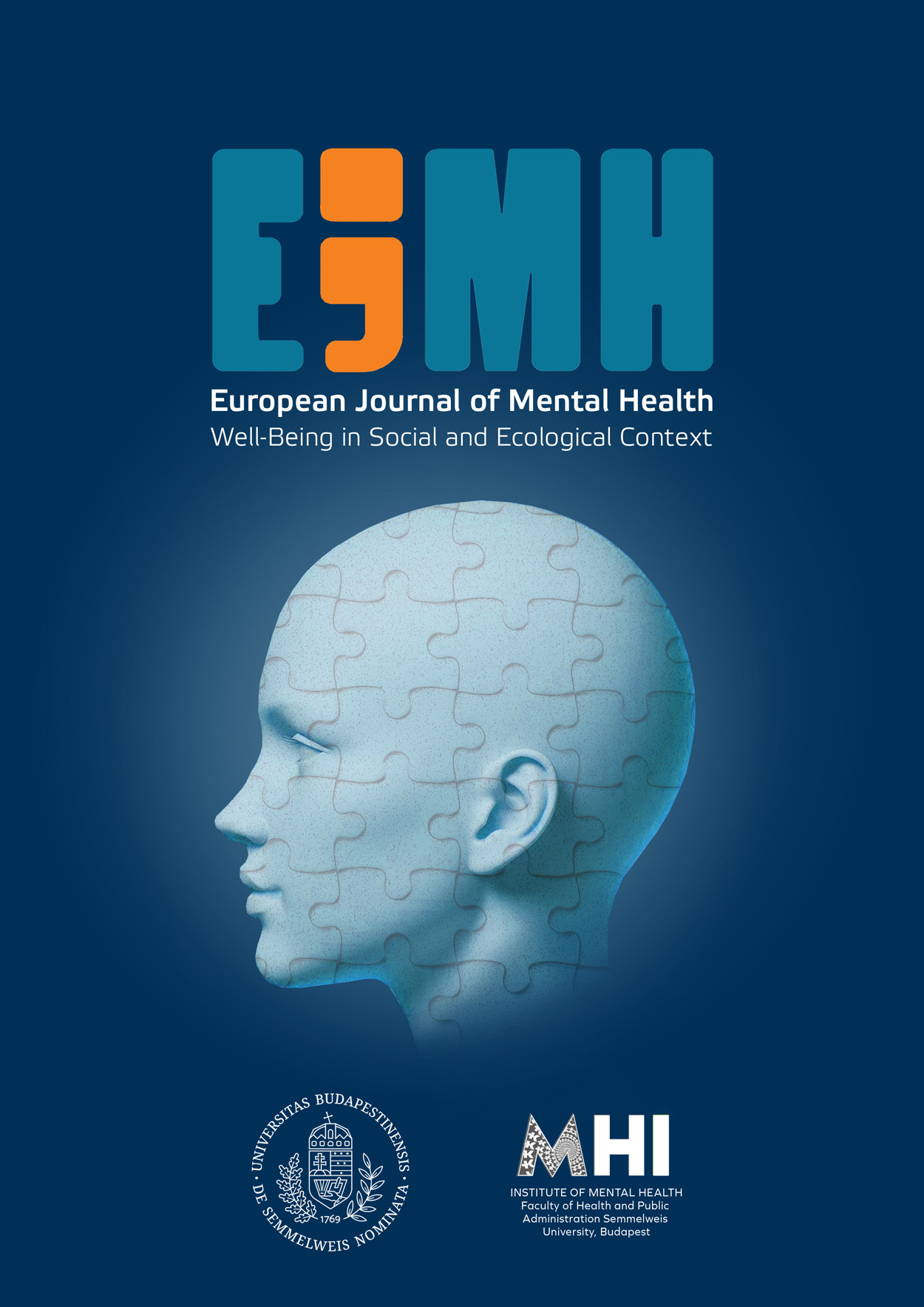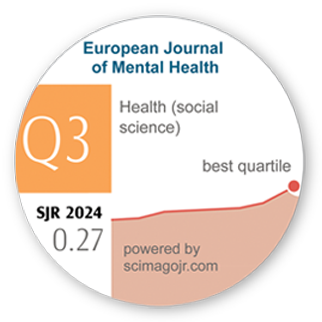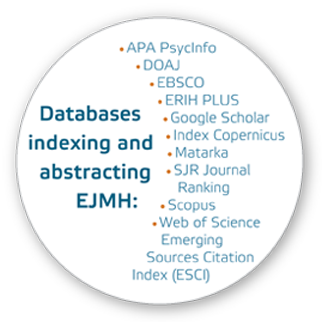Daily Variation in Sleep Duration, Affect and Emotions in Croatian Youth: An Ambulatory Assessment
DOI:
https://doi.org/10.5708/EJMH.19.2024.0022Keywords:
adolescence, mental health, sleep duration, ambulatory assessment, passive sensing dataAbstract
Introduction: Sleep habits are related to mood stability and mental health, and adolescence may be an appropriate time to address disturbed sleep patterns because it is a critical period for the onset of psychological problems.
Aims: This study had two aims, namely: to explore associations between objectively measured sleep duration and positive and negative affect, as well as specific positive and negative emotions at the within-person and between-person levels in Croatian adolescents.
Methods: In the present eight-day study, 102 Croatian adolescents with an average age of 15 years reported how they felt once a day, while sleep duration was objectively measured by collecting data from an accelerometer on participants’ smartphones.
Results: Multilevel analyses showed that adolescents express more positive affect (Est. = 0.10, p < .050) and feel less distracted (Est. = -0.12, p < .050) and happier (Est. = 0.11, p < .050) on days when they sleep longer, with a multiverse analysis suggesting that these results are moderately robust. In addition, they express higher levels of negative affect, stress and distraction on school days, and boys seem to experience more positive and fewer negative emotions.
Conclusions: A better understanding of daily variations in sleep duration, sleep quality, and affect would promote the development of individualized, particularly smartphone-based, sleep interventions. Such interventions could be a valuable tool for preventing mental health problems in adolescence.
References
Aledavood, T., Torous, J., Triana Hoyos, A. M., Naslund, J. A., Onnela, J. P., & Keshavan, M. (2019). Smartphone-based tracking of sleep in depression, anxiety, and psychotic disorders. Current Psychiatry Reports, 21, Article 49.
https://doi.org/10.1007/s11920-019-1043-y
Baglioni, C., Nanovska, S., Regen, W., Spiegelhalder, K., Feige, B., Nissen, C., Reynolds, C. F. III, & Riemann, D. (2016). Sleep and mental disorders: A meta-analysis of polysomnographic research. Psychological Bulletin, 142(9), 969–990.
https://doi.org/10.1037/bul0000053
Bartel, K. A., Gradisar, M., & Williamson, P. (2015). Protective and risk factors for adolescent sleep: A meta-analytic review. Sleep Medicine Reviews, 21, 72–85.
https://doi.org/10.1016/j.smrv.2014.08.002
Bei, B., Allen, N. B., Nicholas, C. L., Dudgeon, P., Murray, G., & Trinder, J. (2014). Actigraphy‐assessed sleep during school and vacation periods: A naturalistic study of restricted and extended sleep opportunities in adolescents. Journal of Sleep Research, 23(1), 107–117.
https://doi.org/10.1111/jsr.12080
Bouwmans, M. E. J., Bos, E. H., Hoenders, H. J. R., Oldehinkel, A. J., & de Jonge, P. (2017). Sleep quality predicts positive and negative affect but not vice versa. An electronic diary study in depressed and healthy individuals. Journal of Affective Disorders, 207, 260–267.
https://doi.org/10.1016/j.jad.2016.09.046
Carskadon, M. A., & Acebo, C. (2002). Regulation of sleepiness in adolescents: Update, insights, and speculation. Sleep, 25(6), 606–614.
https://doi.org/10.1093/sleep/25.6.606
Cousins, J. C., Whalen, D. J., Dahl, R. E., Forbes, E. E., Olino, T. M., Ryan, N. D., & Silk, J. S. (2011). The bidirectional association between daytime affect and nighttime sleep in youth with anxiety and depression. Journal of Pediatric Psychology, 36(9), 969–979.
https://doi.org/10.1093/jpepsy/jsr036
Dejonckheere, E., Mestdagh, M., Houben, M., Rutten, I., Sels, L., Kuppens, P., & Tuerlinckx, F. (2019). Complex affect dynamics add limited information to the prediction of psychological well-being. Nature Human Behaviour, 3, 478–491.
https://doi.org/10.1038/s41562-019-0555-0
Dietvorst, E., Hiemstra, M., Maciejewski, D., van Roekel, E., ter Bogt, T., Hillegers, M., & Keijsers, L. (2021). Grumpy or depressed? Disentangling typically developing adolescent mood from prodromal depression using experience sampling methods. Journal of Adolescence, 88(1), 25–35.
https://doi.org/10.1016/j.adolescence.2021.01.009
Difrancesco, S., Penninx, B. W. J. H., Antypa, N., van Hemert, A. M., Riese, H., & Lamers, F. (2021). The day-to-day bidirectional longitudinal association between objective and self-reported sleep and affect: An ambulatory assessment study. Journal of Affective Disorders, 283, 165–171.
https://doi.org/10.1016/j.jad.2021.01.052
Fuligni, A. J., & Hardway, C. (2006). Daily variation in adolescents’ sleep, activities, and psychological well‐being. Journal of Research on Adolescence, 16(3), 353–378.
https://doi.org/10.1111/j.1532-7795.2006.00498.x
Geldhof, G. J., Preacher, K. J., & Zyphur, M. J. (2014). Reliability estimation in a multilevel confirmatory factor analysis framework. Psychological Methods, 19(1), 72–91.
https://doi.org/10.1037/a0032138
González-Romá, V., & Hernández, A. (2017). Multilevel modeling: Research-based lessons for substantive researchers. Annual Review of Organizational Psychology and Organizational Behavior, 4, 183–210.
https://doi.org/10.1146/annurev-orgpsych-041015-062407
Gradisar, M., Gardner, G., & Dohnt, H. (2011). Recent worldwide sleep patterns and problems during adolescence: A review and meta-analysis of age, region, and sleep. Sleep Medicine, 12(2), 110–118.
https://doi.org/10.1016/j.sleep.2010.11.008
Gujar, N., Yoo, S.-S., Hu, P., & Walker, M. P. (2011). Sleep deprivation amplifies reactivity of brain reward networks, biasing the appraisal of positive emotional experiences. Journal of Neuroscience, 31(12), 4466–4474.
https://doi.org/10.1523/JNEUROSCI.3220-10.2011
Hennig, T., Krkovic. K., & Lincoln T. M. (2017). What predicts inattention in adolescents? An experience-sampling study comparing chronotype, subjective and objective sleep parameters. Sleep Medicine, 38, 58–63.
https://doi.org/10.1016/j.sleep.2017.07.009
Houben, M., Van Den Noortgate, W., & Kuppens, P. (2015). The relation between short-term emotion dynamics and psychological well-being: A meta-analysis. Psychological Bulletin, 141(4), 901–930.
https://doi.org/10.1037/a0038822
Illingworth, G. (2020). The challenges of adolescent sleep. Interface Focus, 10(3), Article 20190080.
https://doi.org/10.1098/rsfs.2019.0080
Johansson, A. E. E., Petrisko, M. A., & Chasens, E. R. (2016). Adolescent sleep and the impact of technology use before sleep on daytime function. Journal of Pediatric Nursing, 31(5), 498–504.
https://doi.org/10.1016/j.pedn.2016.04.004
Keijsers, L., & van Roekel, E. (2018). Longitudinal methods in adolescent psychology: Where could we go from here? And should we? In L. B. Hendry & M. Kloep (Eds.), Reframing adolescent research (pp. 56–77). Routledge.
https://doi.org/10.4324/9781315150611-4
Keyes, K. M., Maslowsky, J., Hamilton, A., & Schulenberg, J. (2015). The great sleep recession: Changes in sleep duration among US adolescents, 1991–2012. Pediatrics, 135(3), 460–468.
https://doi.org/10.1542/peds.2014-2707
Kirtley, O. J., Eisele, G., Kunkels, Y. K., Hiekkaranta, A. P., Van Heck, L., Pihlajamäki, M., Kunc, B., Schoefs, S., Kemme, N., Biesemans, T., & Myin-Germeys, I. (2019, April 2). The Experience Sampling Method (ESM) Item Repository.
https://doi.org/10.17605/OSF.IO/KG376
Li, C.-H. (2021) Statistical estimation of structural equation models with a mixture of continuous and categorical observed variables. Behavior Research Methods, 53, 2191–2213.
https://doi.org/10.3758/s13428-021-01547-z
Lind, M. N., Byrne, M. L., Wicks, G., Smidt, A. M., Allen, N.B. (2018). The Effortless Assessment of Risk States (EARS) Tool: An interpersonal approach to mobile sensing. JMIR Mental Health, 5(3), Article 10334.
https://doi.org/10.2196/10334
Lovato, N., & Gradisar, M. (2014). A meta-analysis and model of the relationship between sleep and depression in adolescents: Recommendations for future research and clinical practice. Sleep Medicine Reviews, 18(6), 521–529.
https://doi.org/10.1016/j.smrv.2014.03.006
Millman, R. P., & Working Group on Sleepiness in Adolescents/Young Adults, & AAP Committee on Adolescence. (2005). Excessive sleepiness in adolescents and young adults: Causes, consequences, and treatment strategies. Pediatrics, 115(6), 1774–1786.
https://doi.org/10.1542/peds.2005-0772
Muthén, L., & Muthén, B. O. (2017). Mplus: Statistical analysis with latent variables: User’s guide (8th ed.). Muthén & Muthén.
Nelson, B. W., & Allen, N. B. (2018). Extending the passive-sensing toolbox: Using smart-home technology in psychological science. Perspectives on Psychological Science, 13(6), 718–733.
https://doi.org/10.1177/1745691618776008
Niemeijer, K., Mestdagh, M., & Kuppens, P. (2022). Tracking subjective sleep quality and mood with mobile sensing: Multiverse study. Journal of Medical Internet Research, 24(3), Article 25643.
https://doi.org/10.2196/25643
Paruthi, S., Brooks, L. J., D'Ambrosio, C., Hall, W. A., Kotagal, S., Lloyd, R. M., Malow, B. A., Maski, K., Nichols, C., Quan, S. F., Rosen, C. L., Troester, M. M., & Wise, M. S. (2016). Consensus statement of the American Academy of Sleep Medicine on the recommended amount of sleep for healthy children: Methodology and discussion. Journal of Clinical Sleep Medicine, 12(11), 1549–1561.
https://doi.org/10.5664/jcsm.6288
Repetti, R. L., Reynolds, B. M., & Sears, M. S. (2015). Families under the microscope: Repeated sampling of perceptions, experiences, biology, and behavior. Journal of Marriage and Family, 77(1), 126–146.
https://doi.org/10.1111/jomf.12143
Rhemtulla, M., Brosseau-Liard, P. É., & Savalei, V. (2012). When can categorical variables be treated as continuous? A comparison of robust continuous and categorical SEM estimation methods under suboptimal conditions. Psychological Methods, 17(3), 354–373.
https://doi.org/10.1037/a0029315
Sadeh, A. (2015). Sleep assessment methods. Monographs of the Society for Research in Child Development, 80(1), 33–48.
https://doi.org/10.1111/mono.12143
Sarchiapone, M., Mandelli, L., Carli, V., Iosue, M., Wasserman, C., Hadlaczky, G., Hoven, C. W., Apter, A., Balazs, J., Bobes, J., Brunner, R., Corcoran, P., Cosman, D., Haring, C., Kaess, M., Keeley, H., Keresztény, A., Kahn, J.-P., Postuvan V., …Wasserman, D. (2014). Hours of sleep in adolescents and its association with anxiety, emotional concerns, and suicidal ideation. Sleep Medicine, 15(2), 248–254.
https://doi.org/10.1016/j.sleep.2013.11.780
Simon, E. B., Vallat, R., Barnes, C. M., & Walker, M. P. (2020). Sleep loss and the socio-emotional brain. Trends in Cognitive Sciences, 24(6), 435–450.
https://doi.org/10.1016/j.tics.2020.02.003
Scott, J., Kallestad, H., Vedaa, O., Sivertsen, B., & Etain, B. (2021). Sleep disturbances and first onset of major mental disorders in adolescence and early adulthood: A systematic review and meta-analysis. Sleep Medicine Reviews, 57, Article 101429.
https://doi.org/10.1016/j.smrv.2021.101429
Scrimin, S., Mason, L., & Moscardino, U. (2014). School-related stress and cognitive performance: A mood-induction study. Contemporary Educational Psychology, 39(4), 359–368.
https://doi.org/10.1016/j.cedpsych.2014.09.002
Short, M. A., Booth, S. A., Omar, O., Ostlundh, L., & Arora, T. (2020). The relationship between sleep duration and mood in adolescents: A systematic review and meta-analysis. Sleep Medicine Reviews, 52, Article 101311.
https://doi.org/10.1016/j.smrv.2020.101311
Solmi, M., Radua, J., Olivola, M., Croce, E., Soardo, L., Salazar de Pablo, G., Shin, J. I., Kirkbride, J. B., Jones, P., Kim, J. H., Kim, J. Y., Carvalho, A. F., Seeman, M. V., Correll, C. U., & Fusar-Poli, P. (2022). Age at onset of mental disorders worldwide: Large-scale meta-analysis of 192 epidemiological studies. Molecular Psychiatry, 27, 281–295.
https://doi.org/10.1038/s41380-021-01161-7
Steegen, S., Tuerlinckx, F., Gelman, A., & Vanpaemel, W. (2016). Increasing transparency through a multiverse analysis. Perspectives on Psychological Science, 11(5), 702–712.
https://doi.org/10.1177/1745691616658637
Talbot, L. S., McGlinchey, E. L., Kaplan, K. A., Dahl, R. E., & Harvey, A. G. (2010). Sleep deprivation in adolescents and adults: Changes in affect. Emotion, 10(6), 831–841.
https://doi.org/10.1037/a0020138
Tsai, M.-C. (2019). The good, the bad, and the ordinary: The day-of-the-week effect on mood across the globe. Journal of Happiness Studies, 20(7), 2101–2124.
https://doi.org/10.1007/s10902-018-0035-7
United Nations Children’s Fund: The State of the World’s Children 2021: On My Mind – Promoting, protecting and caring for children’s mental health. UNICEF.
https://www.unicef.org/media/114636/file/SOWC-2021-full-report-English.pdf
van Zundert, R. M. P., van Roekel, E., Engels, R. C. M. E., & Scholte, R. H. J. (2015). Reciprocal associations between adolescents’ night-time sleep and daytime affect and the role of gender and depressive symptoms. Journal of Youth and Adolescence, 44, 556–569.
https://doi.org/10.1007/s10964-013-0009-3
Wrzus, C., Wagner, G. G., & Riediger, M. (2014). Feeling good when sleeping in? Day-to-day associations between sleep duration and affective well-being differ from youth to old age. Emotion, 14(3), 624–628.
https://doi.org/10.1037/a0035349
Yoon, Y., Eisenstadt, M., Lereya, S. T., & Deighton, J. (2023). Gender difference in the change of adolescents’ mental health and subjective wellbeing trajectories. European Child & Adolescent Psychiatry, 32(9), 1569–1578.
https://doi.org/10.1007/s00787-022-01961-4






